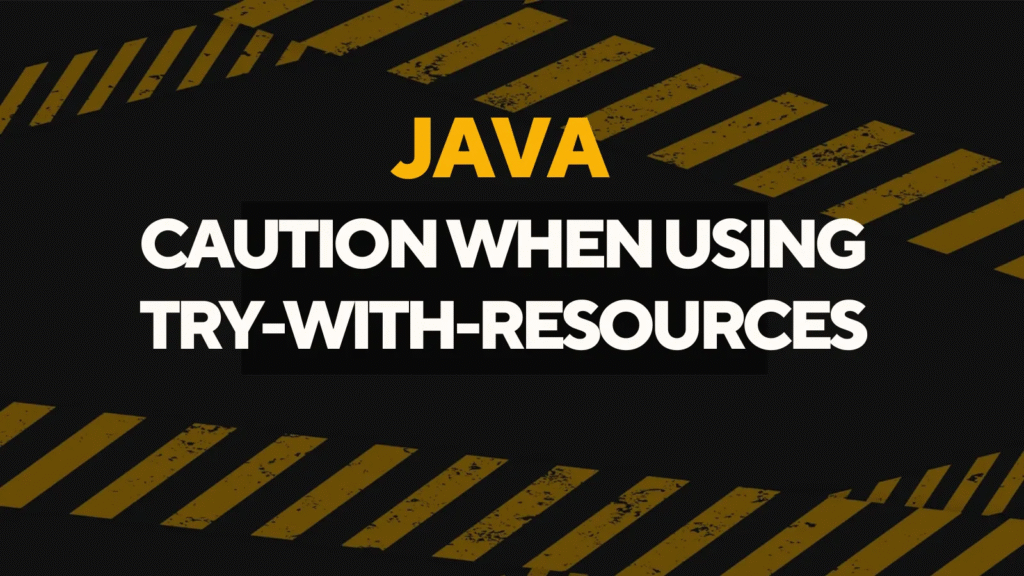The try-with-resources statement in Java is a powerful feature introduced in Java 7 to simplify resource management. It ensures that resources, such as streams, files, and connections, are closed automatically, thereby reducing the likelihood of resource leaks. However, there are important considerations and potential pitfalls when using this construct.
How to handle Try-With-Resources with caution
1. Ignoring Suppressed Exceptions
When multiple resources are used in a try-with-resources block, if both the try block and the close method of a resource throw exceptions, the exception from the close method is suppressed. Failing to handle suppressed exceptions can lead to critical debugging oversights.
Bad Practice:
try (
ResourceA resA = new ResourceA();
ResourceB resB = new ResourceB()
) {
throw new RuntimeException("Primary Exception in try block");
} // The exception from close() on resB is suppressed and ignoredExplanation:
- If
resB.close()It also throws an exception; it will be suppressed by the runtime and not printed unless explicitly handled. - This can obscure the real issue if the closing logic of the resource needs to be fixed.
Fix:
Handle suppressed exceptions:
try (
ResourceA resA = new ResourceA();
ResourceB resB = new ResourceB()
) {
throw new RuntimeException("Primary Exception in try block");
} catch (Exception e) {
System.err.println("Caught exception: " + e.getMessage());
for (Throwable suppressed : e.getSuppressed()) {
System.err.println("Suppressed exception: " + suppressed.getMessage());
}
}2. Relying on Non-Idempotent close() Implementation
If the close method of a resource has side effects or is not idempotent (safe to call multiple times), it can cause application instability.
Bad Practice:
class BadResource implements AutoCloseable {
private boolean closed = false;
@Override
public void close() {
if (closed) {
throw new RuntimeException("Resource already closed!");
}
System.out.println("Closing resource...");
closed = true;
}
}
try (BadResource resource = new BadResource()) {
// Do something
} // The application may crash if close is called again internally.Explanation:
- If
closeis called multiple times (e.g., due to runtime retries or nested calls), it throws aRuntimeException, leading to unpredictable behavior.
Fix:
Ensure the close Method is idempotent:
class SafeResource implements AutoCloseable {
private boolean closed = false;
@Override
public void close() {
if (!closed) {
System.out.println("Closing resource...");
closed = true;
}
}
}3. Resource Dependency Mismanagement
When resources depend on one another, failing to manage their initialization and closing order can lead to runtime errors.
Bad Practice:
try (
ResourceA resA = new ResourceA();
ResourceB resB = new ResourceB(resA)
) {
// Do something with resA and resB
} // resB may depend on resA being open when it's closingExplanation:
- If
resBdepends onresAduring itsclosemethod (e.g., shared file handles, network sockets), closingresAfirst can lead to errors.
Fix:
Declare dependent resources in separate try-with-resources blocks:
try (ResourceA resA = new ResourceA()) {
try (ResourceB resB = new ResourceB(resA)) {
// Use resources
}
}4. Using Try-With-Resources with Non-Closeable Resources
Developers sometimes mistakenly try to manage non-closeable resources, such as plain objects, with try-with-resources. This leads to compilation errors or logical errors.
Bad Practice:
try (String nonCloseable = "Non-Closeable Resource") {
System.out.println(nonCloseable);
}Explanation:
Stringdoes not implementAutoCloseable, so the above code will not compile.
Fix:
Only use resources that implement AutoCloseable:
try (BufferedReader reader = new BufferedReader(new FileReader("file.txt"))) {
System.out.println(reader.readLine());
}5. Mixing Manual and Automatic Resource Management
Manually closing resources inside a try-with-resources block defeats the purpose of automatic management and can lead to double-closing or resource leaks.
Bad Practice:
try (BufferedReader reader = new BufferedReader(new FileReader("file.txt"))) {
System.out.println(reader.readLine());
reader.close(); // Manually closing, unnecessary and risky
}Explanation:
reader.close()is called twice: once manually and once by try-with-resources. This can lead to errors or undefined behavior in some resource implementations.
Fix:
Let the try-with-resources block handle the cleanup:
try (BufferedReader reader = new BufferedReader(new FileReader("file.txt"))) {
System.out.println(reader.readLine());
}6. Ignoring Initialization Failures
If a resource fails to initialize, the try-with-resources block will not execute, and the exception must be handled.
Bad Practice:
try (BufferedReader reader = new BufferedReader(new FileReader("nonexistent.txt"))) {
System.out.println(reader.readLine());
}Explanation:
- The
FileReaderconstructor throws an exception if the file does not exist. The block body won’t run, and the exception might propagate without being handled.
Fix:
Handle initialization exceptions:
try (BufferedReader reader = new BufferedReader(new FileReader("nonexistent.txt"))) {
System.out.println(reader.readLine());
} catch (IOException e) {
System.err.println("Error initializing resource: " + e.getMessage());
}Conclusion
The try-with-resources statement is a powerful feature for resource management, but improper usage can lead to application errors, suppressed exceptions, and unpredictable behavior. Avoid these bad practices by:
- Ensuring resource
closemethods are idempotent and side-effect-free. - Handling suppressed exceptions for better debugging.
- Declaring dependencies clearly and separating them when necessary.
- Using only valid
AutoCloseableresources. - Allowing the block to manage cleanup without interference.
By following these guidelines, you can leverage try-with-resources effectively and prevent resource-related issues.



